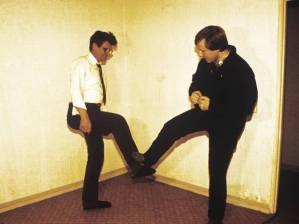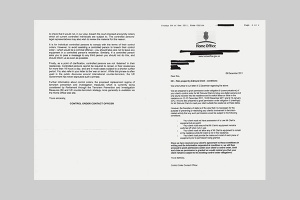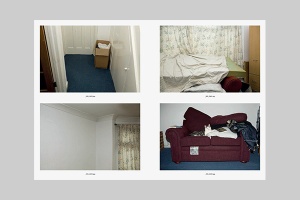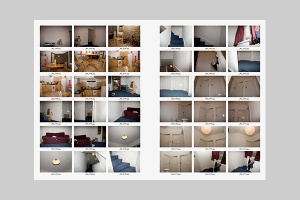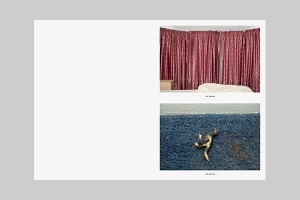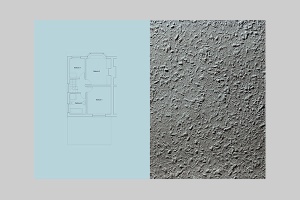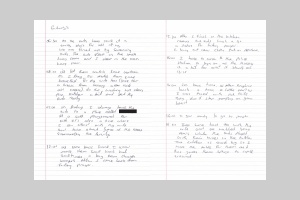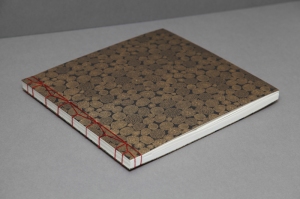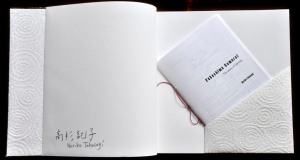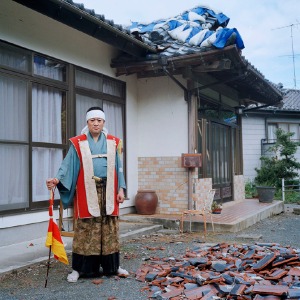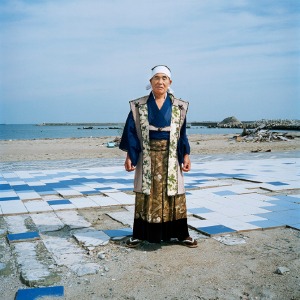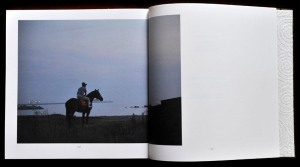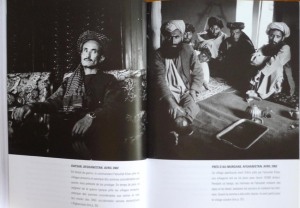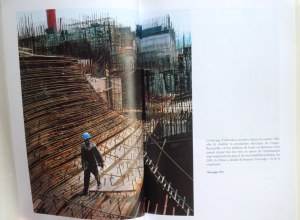Meta-photography, surveillance and control.
Posted: October 31, 2013 Filed under: Photobooks, Photography 5 CommentsWe have discovered recently that our whole society is under surveillance and control.
It has recently been revealed that our society is under the NSA surveillance. Yes the previous sentence is cancelled because I don’t imagine that anybody would have been credulous enought to not knowing that ! Just to remind you, in 1988, the existence of the Echelon spy network was already revealed.
Well, these revelations are, for me, the opportunity to talk about six pieces of work connected to this topic.
The first one « I wish you were here », was realised during an artist residency. A book was published in 2011, as an artist book of 40 copies, printed on risography, by Eduardo Serafim. For the series, Eduardo got access, via internet, to some surveillance cameras which were monitoring public or private spaces. From the pictures captured, he made postcards which were sent to public people, indicating the IP address of the camera and the words : I wish you were here. This work emphasizes the relationship between citizens and privacy. Eduardo first reveals how much everything we do is monitored (even with the agreement of people who accept the monitoring because of the safety) and how easy it is to get access to this monitored world, then becoming an intruder or voyeur in someone else’s life. It also questions the fact that, even if we know that we are under surveillance, do we really understand what it means ? And knowing that, will this change our way of acting in a monitored area ? In a second level, he plays with the interaction between private and public by sending the printed postcards to public people. We mainly send postcards to people we know in our privacy circle, so the questions become : how much do we know someone, and what means knowing someone ? Well, in which society do we live ?
http://www.eduardoserafim.com/iwishyouwerehere.html
The second one is Andrew Hammerand « The New Town », another artist book published in a limited edition of 25. The photos are all taken from one single point of vue from a controllable security camera, in a midwestern town, showing people outside, shopping, siting on a lawn or the town at night. What we discover is a slice of time in the life of a town and we can only imagine what are the activities that are monitored: behind trees, we discover some people who may either be burglars or friends talking outside. The use of a security camera draws our mind to suspect and question what we see. Again, for the purpose of security, people accept to be under surveillance, and here again, it questions this acceptance. The book becomes a kind of security report notebook for safety purposes, even using a spiral bound.
http://www.andrewhammerand.com/the_new_town/index.html
The next book that I will talk about is Joachim Schmid recent « X marks the spot ». Joachim Schmid is an activist in book publishing, using a lot the « print on demand » process. Here he shows a collection of pictures made with the camera located in Dallas – Texas, on Dealey Plaza. The originality of this camera is that its purpose is not the security. This location is the exact point of vue that had the sniper when he killed J. F. Kennedy on November 22, 1963. Everyday, many people try to avoid cars to reach the X marked on the ground, indicating the position of the car of the President, to be photographed on the site. This book fits completely with the manifesto which was proclaimed in 2012 in Arles, called « From here on », as a statement for the basis of a new photography, whom Joachim Schmid was one of the signatories. This work tells less about control and surveillance than about the appropriation of an historical event with the new materials and technologies, but also about globalization which means that we are able to transport ourselves on the other side of the planet to be spectator, or voyeur, of an instant. It is dizzying when you see someone on the other side of the camera who is moving : could, this person, at this precise moment, have in mind that you are watching him from your desktop ? (at least this is what I feel when I use those kind of livecams).
http://schmid.wordpress.com/works/x-marks-the-spot-2013/
http://schmidbooks.wordpress.com/
http://www.earthcam.com/usa/texas/dallas/dealeyplaza/
About surveillance, a nice book has been published this year. It is « Top Secret, Images from the Archives of the Stasi » by Simon Menner. In 1992, the archives of the Ministerium für Staatssicherheit commonly known as the Stasi, were officially opened to the public. Thematically, the book presents some of those treasures, chapter by chapter. We find photos of people or locations (mailboxes…) who have been under surveillance, but the best part is the collection of photos for the instruction of agents, like disguises collection or the use of secret codes to communicate and remaining under cover. With all due respect to the period and what it meant, some photos are hilarious.
http://www.simonmenner.com/pages/Stasi-Index.htm
http://www.hatjecantz.de/simon-menner-top-secret-5654-1.html
http://www.hatjecantz.de/fotoblog/?p=2155
The two last photographers whose I will talk, share the same topic, which is more about control than surveillance (and they also share nationality, they are both from England).
The first one is David Moore and his book « The last things » was published in 2008. From September 2006 to April 2007, David Moore, with the support of Arts Council of England, was granted access to the underground military facility which is maintained to be used in case of emergency. It is a fully equiped facility from where the government could continue to lead the country. In the photographs, we only see some furnitures, objects, rooms and cupboards. It looks like an unused area, what it is in fact, but, what is frightening, is that everything is prepared to be used and everything is considered at the same level, whatever it is a bibelot or a broadcasting video camera, prepared for some emergency statement. We can almost feel claustrophobic because of the absence of natural light. It has a lot of similarities with a prison, with corridors and doors/gates. What makes this facility so oppressive is also the fact that we know the purpose of it. Every important data has been erased on request, so things here are very serious. If that would be a kind of playground for kids, we would completely change our mind when reading the photos, but knowing the purpose, we can’t avoid thinking to a post disaster world as seen in some anticipation books or movies, imagining the deserted chaos outside, and knowing that we would stay outside as all other common people.
http://davidmoore.uk.com/projects/the-last-things
The last book I will talk about was published early this year and is one of my favorite book of the year. « Control order house », by Edmund Clark was published by Here Press. Edmund Clark was already known for his work in Guantanamo « If the light goes out » which was a reflection about the different ways of living in Guantanamo and the consideration of what is « home » for detainees and militaries. The subject of Edmund Clark’s new work is a house in which people, under suspicion of terrorism, are detained. For the book, Edmund Clark was allowed to stay, as a guest, in the house, together with the controlled man, detained here. This were three days in December 2011. In the book, Edmund mixes photographs and documents about, as he is named, CE’s case, as a diary, letters, and trial pieces. What he shows in his photographs is a documentation of the house. Each photo is automatically named by the camera, from _MG_2555.jpg to _MG_3065.jpg which supposes that none of the pictures have been erased. It becomes a complete recording of each square foot. The missing of a recognisable name prevents us to appropriate the photos. With the simple name of « sofa » we could throw ourselves, by imagination, and sit on the sofa but it remains impossible because it is not a sofa, it is just a number. This reminds us the famous series « The Prisonner » who claimed « I am not a number, I am a free man ». The denial of a name, by metaphor becomes the negation of freedom. Here the control and surveillance is felt by the quantity of photos which means that no corner, neither object has been omitted. No part of the house can remain secret or hidden (here again is a strong analogy with the series in which the prisonner always knew he was observed). The only warm presence, in the series, is a cat and everything is unpersonal because the identity of the man living here must remain unknown and the same for the location of the house. Aesthetics of the pictures is absolutely raw and they look like blind shots without framing, or made with a hidden camera. This raw quality emphasizes the impression of a restricted area where photos are not allowed which is, again, a denial of freedom (since the Vietnam war, the governements know that what has to remain unknown must not be photographed). The photos could come from the archive of a secret police or could have been shot by a programed computer directed by a remote control. It becomes very disturbing when we experience the feeling and the anxiety of a custody.
http://www.herepress.org/publications/edmund-clark-control-order-house/
All images copyright Eduardo Serafim, Andrew Hammerand, Joachim Schmid, Simon Menner, David Moore, Edmund Clark and the publishers. Can be removed on request.
Fukushima Samurai, by Noriko Takasugi
Posted: October 19, 2013 Filed under: Photobooks 1 CommentI am a unconditional fan of Kenji Misumi, Hideo Gosha, Eiichi Kudo or Kihachi Okamoto. After this first sentence, you may think that I am going to talk about japanese cinema, and more precisely about those four film makers who have been worldwide famous with samurai films.
In fact, what I want to talk about, is one of the most beautiful book I have seen for the last few years. This book is called Fukushima Samurai, the story of identity, and the photographer is Noriko Takasugi. The book is a huge square book, 27 x 27 cm, 114 pages with 88 color photographs. The book also includes a booklet of 29 pages with texts in English. It is a tradional Japanese book binding, printed digitally on Indigo printer and it is a more than ultra limited print run… So far only 9 copies are circulating worldwide. Each copy is handmade with an incredible care. With this book, we are probably beyond the photobook object and closer to an artwork. Photos can hardly give justice to such a gorgeous object !
Well, this was for the facts, but what is this book about ? The book is about samurai, but moreover, it is about the loss of identity after the earthquake that happened in Fukushima in March 2011. The book is divided in 8 chapters and the first one shows us the area of Fukushima, with people, animals and landscapes. We suppose that it was before the disaster, everything seems to be quiet and peaceful.
The second part is called « The disaster and radiation » and we discover what remains after the earthquake : destroyed houses, flowers in memory of disapeared persons, or abandonned living room with a table dressed for a lunch, witnessing the precipitation of the evacuation.
These two chapters were introducing the context and, with the third part made of samurai portraits, we enter the heart of the story. Ten protraits are printed on foldout pages (like an inner leporello of 5 pictures each). These portraited men have been relocated after the disaster and Noriko was allowed to accompany them for a short trip in the contaminated area to portray them, wearing tradionnal clothes of their samurai clan, in a place they chose. They are all originated from this area, and Noriko is using them as a metaphor. According to the code of honnor, a samurai has to protect and defend his clan, which can be transposed in modern society to family and friends. We see the samurai standing in front of the camera, in a place which symbolises their loss (a former relative’s house, a place they have built…). There is a contrast between their beautiful traditionnal clothes and the chaos around them and, what we see in their eyes, is the distress of a failure : what can a samurai do against a nuclear hazard ? From my point of view, this part is the most poignant with the minimalism of the frontal composition.
These men are Nomaoi-men and in the following chapters we will know more about their lifes. The fourth chapter is about horses (hundreds of them were lost after the disaster) and the fifth, about the traditionnal life. We discover them training, preparing for a ceremony, wearing their armors, all mixed with photos of details of objects.
The sixth chapter is dedicated to the traditionnal event of Soma Nomaoi, in 2012. The event was held since 973 and usually brings together 500 samurai. After many talks and debates, the organisers decided to maintain the organisation in order to support and show solidarity for people from Odaka county but only 82 samurai managed to join this year. Many samurai have left their armor when leaving their home and many of which were still irradiated but they wanted to wear them without a doubt. The three days festival is the occasion for the samurai to show their skills during parades and traditionnal games or fights. We discover, in the photographs, that, despite the remaining level of contamination, the whole population was celebrating together the values of the Japanese society and, above all, the affirmation that they are alive, united against the threat and full of hope!
After the three days of full joy, we are back to reality in the last two chapters. The seventh one is a collection of small pictures of Geiger counters and food which symbolise the stress of the photographer who always had to bring with her a measurement counter, not really knowing if the radiation would contaminate her, during his one month stay. The photos of food show her own doubts about the origin of what she ate, always trying to buy products that were not produced in Fukushima district. The last chapter works like a loop with the beginning of the book. We see people living in Minamisoma city, working for the decontamination, or back to their common duties. The nuclear threat is invisible and we will have to wait for a few decades to really know what was the level of Fukushima nuclear disaster.
The last photo in the book shows a man on a horse, looking at the sea in the twilight. We understand the symbolism of the image knowing how much radioactivity has been thrown away in the sea… This is a young man, he symbolises all the hope of a population, but also of a nation!
More info here : http://www.norikotakasugi.com/
An interesting read here too : http://www.disphotic.lewisbush.com/2013/05/01/review-fukushima-samurai-by-noriko-takasugi/
Another Japanese book about horses and Fukushima which is worth a look : http://www.the-new-frame.com/#yutaka-fujii-i-am-a-horse
See also on the subject my previous post : https://whoneedsanotherphotoblog.wordpress.com/2013/07/21/fukushima-two-japanese-photographers-witness-the-area/
All images copyright Noriko Takasugi (can be removed on request)
Photobook form, photobook sense. Part two.
Posted: October 6, 2013 Filed under: Photobooks, Photography Leave a commentIt is now time to publish the second part of my thoughts on photobook form, photobook sense. I will develop here three different concepts which present, each, a different form in relation with a piece of work of a photographer. These are publications, but they may not be considered as traditionnal photobooks.
The first one is Paolo Woods. He grew up in Italy before settling in Paris where he published most of his books. He is what we can call a « concerned photographer » investigating some very powerful subjects like the oil industry (Un monde de brut – A crude world), the wars in Afghanistan and in Iraq (American chaos), the Chinese companies which are economically conquering Africa (La Chinafrique, which refers to the old word Françafrique, and a second volume called China safari)), the Iranian society (Marche sur mes yeux – Walk on my eyes) and the aftermath of the cyclone in Haiti (Etat – State).
Paolo does not care about creating aesthetic artist books, he wants his work to be widely known so that everybody can feel concerned by the subjects and the publications are often published as an essay rather than a photobook. Mainly published in France, with Serge Michel as a writer, they work together as investigators, sometimes with some other writers on some stories (Serge Enderlin, Michel Beuret). The print run for each book is a few thousand copies and those kind of books are never, or rarely, out of print, you can even find them very cheap on the second hand market. This is the exact opposite of some hand crafted ultra limited artist books and, with this particular form, it really gives a strong sense and an added value to the work.
The second one is a French man living In Japan. Bruno Quinquet was working in France as a sound engineer. One day, he decided to quit his job and left for Japan where he studied photography. This was the beginning of his fascinating series : The salaryman project. The subject of his work is this particular part of the society formed by the salarymen in Japan. To support his work, he created a fictionnal company called Bureau d’Etudes Japonaises which emphasizes his thematic.
Bruno, under the guise of the right of image, never shows the faces of the salarymen, they are part of the pictures and, with lyricism, we discover them as a part of an abstract photo. There are many references to the Japanese society in Bruno’s work and I cannot stop thinking of Hiroshige’s hundred views of Edo with his appropriation of the use of foregrounds and backgrounds. What is also fascinating is the freshness and even the sort of joy that reflected those photographs while the world of salarymen is supposed to be very rough and stressful. We can find similarities in those scenes, with children in playgrounds, but in fact, are not the streets of Tokyo the salarymen’s playground. Last but not least, Bruno published for the second year a wonderful publication in the form of a « salaryman project business schedule ». This is a real agenda that you can use, illustrated with one picture per week. The softcover book size is 18,2 x 25,7 cm with 64 pages and 53 photos, they both come with an insert (in 2013 with an essay about salarymen, and in 2014 with a sealed enveloppe including a confidential file). Print run of 500 copies each.
The third example that I want to introduce was shot in Marseille – France. In 2013, Marseille was one of the European capital of culture, supporting many cultural projects. One of those projects was the creation of a hiking path (called GR 2013) in Marseille suburban area. Traditionnaly, those paths are supposed to guide you through wonderful natural landscapes and the great ingeniosity of the GR 2013 is that it guides you through « man altered landscapes » (yes, I am refering to the New Topographics exhibition). This creation was accompanied by a photo project on this territory. The building of a landscape photographic observatory. It consists in the realisation of one hundred referenced pictures which are going to be reconducted year after year to witness the changing of landscape. Two photographers who called themselves « the panoramists » were in charge of the project : Geoffroy Mathieu Bertrand Stofleth and the photo project was named « Paysages usagés » (in the meaning of altered landscpaes, so now, you understand my previous assertion). I like a lot this work, also because, to be honnest, I feel more comfortable in suburban landscapes than in magnificient outdoors. The result was published in the form of a collector postcards box (limited to 250 copies), including the one hundred shots, each printed on a postcard.
The design of the box is very similar to the small series of postcards that we could buy, as a souvenir, in touristic areas. The idea of magnifying an altered territory, so that we can consider it as a valuable site of promenade, questions the viewer on the role of photography and the never ending question of beauty. Each photo includes a drawn white line showing the location of the hiking path on the photographed landscape. And, by the way, the path is 365 km long and is worth a look.
As usual, some links if you want more information :
http://www.brunoquinquet.com/en/about_en.html
http://www.geoffroymathieu.com/
http://www.bertrandstofleth.com/
All images copyright Paolo Woods, Bruno Quinquet, Geoffroy Mathieu, Bertrand Stofleth and the publishers. (can be removed on request)



















